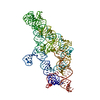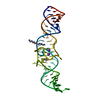+ Open data
Open data
- Basic information
Basic information
| Entry | Database: PDB / ID: 8tvz | |||||||||||||||||||||
|---|---|---|---|---|---|---|---|---|---|---|---|---|---|---|---|---|---|---|---|---|---|---|
| Title | RNA origami 3-helix tile Traptamer | |||||||||||||||||||||
 Components Components | RNA (363-MER) | |||||||||||||||||||||
 Keywords Keywords | RNA / Origami / aptamer / switch / sensor / toe-hold / robot / broccoli | |||||||||||||||||||||
| Function / homology | RNA / RNA (> 10) / RNA (> 100) Function and homology information Function and homology information | |||||||||||||||||||||
| Biological species | synthetic construct (others) | |||||||||||||||||||||
| Method | ELECTRON MICROSCOPY / single particle reconstruction / cryo EM / Resolution: 5.94 Å | |||||||||||||||||||||
 Authors Authors | McRae, E.K.S. / Vallina, N.S. / Andersen, E.S. | |||||||||||||||||||||
| Funding support | European Union,  Denmark, Denmark,  Canada, 6items Canada, 6items
| |||||||||||||||||||||
 Citation Citation |  Journal: Sci Adv / Year: 2024 Journal: Sci Adv / Year: 2024Title: An RNA origami robot that traps and releases a fluorescent aptamer. Authors: Néstor Sampedro Vallina / Ewan K S McRae / Cody Geary / Ebbe S Andersen /   Abstract: RNA nanotechnology aims to use RNA as a programmable material to create self-assembling nanodevices for application in medicine and synthetic biology. The main challenge is to develop advanced RNA ...RNA nanotechnology aims to use RNA as a programmable material to create self-assembling nanodevices for application in medicine and synthetic biology. The main challenge is to develop advanced RNA robotic devices that both sense, compute, and actuate to obtain enhanced control over molecular processes. Here, we use the RNA origami method to prototype an RNA robotic device, named the "Traptamer," that mechanically traps the fluorescent aptamer, iSpinach. The Traptamer is shown to sense two RNA key strands, acts as a Boolean AND gate, and reversibly controls the fluorescence of the iSpinach aptamer. Cryo-electron microscopy of the closed Traptamer structure at 5.45-angstrom resolution reveals the mechanical mode of distortion of the iSpinach motif. Our study suggests a general approach to distorting RNA motifs and a path forward to build sophisticated RNA machines that through sensing, computing, and actuation modules can be used to precisely control RNA functionalities in cellular systems. | |||||||||||||||||||||
| History |
|
- Structure visualization
Structure visualization
| Structure viewer | Molecule:  Molmil Molmil Jmol/JSmol Jmol/JSmol |
|---|
- Downloads & links
Downloads & links
- Download
Download
| PDBx/mmCIF format |  8tvz.cif.gz 8tvz.cif.gz | 218.8 KB | Display |  PDBx/mmCIF format PDBx/mmCIF format |
|---|---|---|---|---|
| PDB format |  pdb8tvz.ent.gz pdb8tvz.ent.gz | 152.4 KB | Display |  PDB format PDB format |
| PDBx/mmJSON format |  8tvz.json.gz 8tvz.json.gz | Tree view |  PDBx/mmJSON format PDBx/mmJSON format | |
| Others |  Other downloads Other downloads |
-Validation report
| Summary document |  8tvz_validation.pdf.gz 8tvz_validation.pdf.gz | 981.5 KB | Display |  wwPDB validaton report wwPDB validaton report |
|---|---|---|---|---|
| Full document |  8tvz_full_validation.pdf.gz 8tvz_full_validation.pdf.gz | 994.1 KB | Display | |
| Data in XML |  8tvz_validation.xml.gz 8tvz_validation.xml.gz | 24.7 KB | Display | |
| Data in CIF |  8tvz_validation.cif.gz 8tvz_validation.cif.gz | 35.3 KB | Display | |
| Arichive directory |  https://data.pdbj.org/pub/pdb/validation_reports/tv/8tvz https://data.pdbj.org/pub/pdb/validation_reports/tv/8tvz ftp://data.pdbj.org/pub/pdb/validation_reports/tv/8tvz ftp://data.pdbj.org/pub/pdb/validation_reports/tv/8tvz | HTTPS FTP |
-Related structure data
| Related structure data |  41656MC M: map data used to model this data C: citing same article ( |
|---|---|
| Similar structure data | Similarity search - Function & homology  F&H Search F&H Search |
- Links
Links
- Assembly
Assembly
| Deposited unit | 
|
|---|---|
| 1 |
|
- Components
Components
| #1: RNA chain | Mass: 116977.742 Da / Num. of mol.: 1 / Source method: obtained synthetically / Source: (synth.) synthetic construct (others) |
|---|
-Experimental details
-Experiment
| Experiment | Method: ELECTRON MICROSCOPY |
|---|---|
| EM experiment | Aggregation state: PARTICLE / 3D reconstruction method: single particle reconstruction |
- Sample preparation
Sample preparation
| Component | Name: 14-14 Traptamer / Type: COMPLEX Details: An RNA origami 3 helix tile with an inactive broccoli aptamer in the central helix. Entity ID: all / Source: RECOMBINANT | ||||||||||||||||||||
|---|---|---|---|---|---|---|---|---|---|---|---|---|---|---|---|---|---|---|---|---|---|
| Molecular weight | Experimental value: NO | ||||||||||||||||||||
| Source (natural) | Organism: synthetic construct (others) | ||||||||||||||||||||
| Source (recombinant) | Organism: synthetic construct (others) | ||||||||||||||||||||
| Buffer solution | pH: 7.5 | ||||||||||||||||||||
| Buffer component |
| ||||||||||||||||||||
| Specimen | Conc.: 2 mg/ml / Embedding applied: NO / Shadowing applied: NO / Staining applied: NO / Vitrification applied: YES | ||||||||||||||||||||
| Specimen support | Details: 15mA / Grid material: GOLD / Grid mesh size: 300 divisions/in. | ||||||||||||||||||||
| Vitrification | Instrument: LEICA EM GP / Cryogen name: ETHANE / Humidity: 100 % / Chamber temperature: 294 K / Details: Protochips Au-Flat 1.2/1.3 grids. |
- Electron microscopy imaging
Electron microscopy imaging
| Experimental equipment |  Model: Titan Krios / Image courtesy: FEI Company |
|---|---|
| Microscopy | Model: FEI TITAN KRIOS |
| Electron gun | Electron source:  FIELD EMISSION GUN / Accelerating voltage: 300 kV / Illumination mode: FLOOD BEAM FIELD EMISSION GUN / Accelerating voltage: 300 kV / Illumination mode: FLOOD BEAM |
| Electron lens | Mode: BRIGHT FIELD / Nominal defocus max: 2000 nm / Nominal defocus min: 500 nm / Cs: 2.7 mm / C2 aperture diameter: 70 µm |
| Image recording | Electron dose: 60 e/Å2 / Film or detector model: GATAN K3 BIOQUANTUM (6k x 4k) / Num. of grids imaged: 1 / Details: Pixel size of 0.645 A/px |
| EM imaging optics | Energyfilter name: GIF Bioquantum / Energyfilter slit width: 20 eV |
- Processing
Processing
| EM software |
| |||||||||||||||||||||
|---|---|---|---|---|---|---|---|---|---|---|---|---|---|---|---|---|---|---|---|---|---|---|
| CTF correction | Type: PHASE FLIPPING AND AMPLITUDE CORRECTION | |||||||||||||||||||||
| 3D reconstruction | Resolution: 5.94 Å / Resolution method: FSC 0.143 CUT-OFF / Num. of particles: 220000 / Symmetry type: POINT | |||||||||||||||||||||
| Atomic model building | Protocol: OTHER | |||||||||||||||||||||
| Atomic model building | PDB-ID: 5OB3 Accession code: 5OB3 / Source name: PDB / Type: experimental model |
 Movie
Movie Controller
Controller



 PDBj
PDBj






























